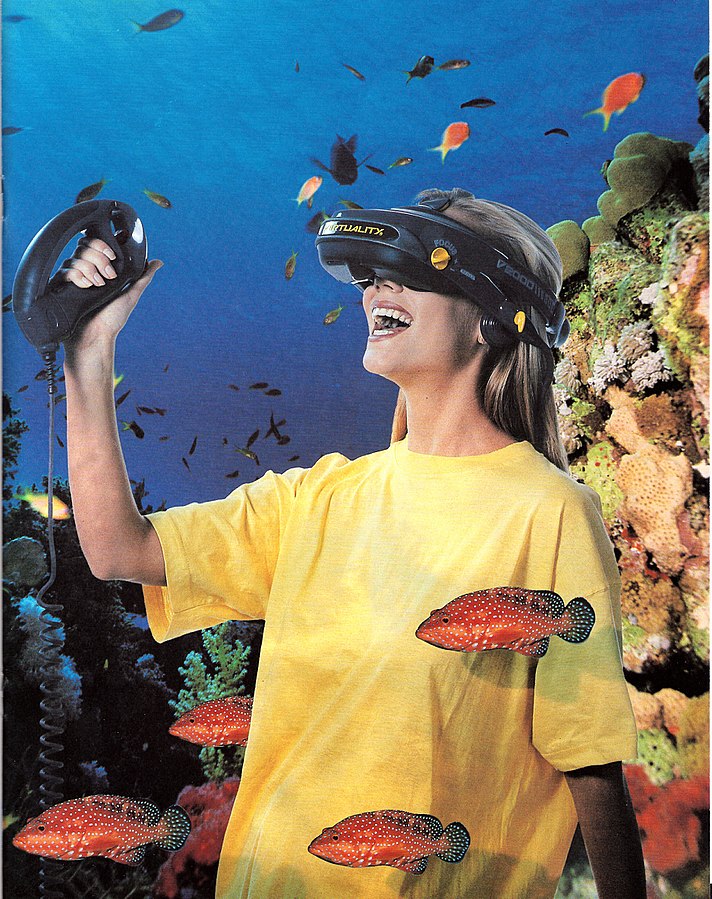Tom’s Soapbox: Why This Early Adopter Is Still Waiting On VR
To say I'm not excited about current-generation virtual reality headsets such as those from Sony, Oculus/Facebook, and HTC would be inaccurate. I have yet, however, to pillage my bank account and purchase one of these beasties. I've seen modern virtual reality in action, and as impressive as it is, I've seen it all before—long before actually, in the early days of 3D gaming. VR had an earlier heyday during the Age of Grunge, and the Decade of Flannel: the 1990s.
3D-dedicated hardware like 3dfx's Voodoo Graphics chipset, which was available on cards that worked in conjunction with a system's 2D display card, were just emerging at that time. Blocky, pixelated graphics dependent on sprites gave way to smoother, faster, more-impressive visuals thanks to these "3D accelerators." Eventually, the industry presented 2D/3D combined cards, sort of like the ones that our systems use today—only they weighed a lot less back then because they weren’t nearly as powerful as the Radeon and GeForce cards of today.
VR's Big, Bulky Past
What didn't weigh less were the first VR goggles. These headsets of yesteryear debuted with blocky, pixelated graphics and neck-straining bulk, all to render low-frame-rate visuals that flickered a lot and—for some unfortunate users—also produced splitting headaches. If you happen to still have one of those headsets of yesteryear, the layer of dust on it might be worth investigating for archeological research.
In other words, I’ve been bitten by VR before. And I’m still holding back in wariness of having experienced the gaming world’s first, sputtering attempts to kick-start wearable immersion.
VR Is Still Too Pricey
Another reason I’m not jumping aboard yet—and this is a big one—is price. It's cool to be a tech journalist, because we often get to play with the latest bleeding-edge tech. But early on, the newest is also the most expensive. The original HTC Vive debuted at $800, and the Rift went on sale to the general public for $600—without motion controllers. Granted, the tech (and bulkiness) has much improved since Nirvana’s In Utero first landed on record-store shelves. But today’s headsets still feel clunky, have cumbersome wires, and feel awkwardly isolating. That last bit feels particularly odd given our current world of constant connectivity, nifty wireless gear, and e-enabled social interaction.
Thankfully, tech prices drop as time goes by, and both the first-generation Vive and the Facebook-backed Oculus Rift are down to about $500 at the time of this writing. But $500 is still a lot of money for a tethered viewfinder that requires an expensive gaming computer to use. And if you don’t happen to already own a graphics card capable of handling VR, you can forget about buying one without paying several hundred bucks over MSRP nowadays. Thank ongoing coin-minding demand for that.
Where Are the Must-Play Games?
And games? The pickings aren't slim, but where are all the AAA titles with glorious, head-tracking impressiveness? Super Hot VR and Robo Recall are fun, to be sure. And it's fantastic that some franchises familiar to the traditional gaming masses—such as Fallout, Doom, and Elite Dangerous, are available in VR forms. Most of the major titles landing this year, however, appear bereft of VR support. And battle royale titles like Fortnite and PUBG are clearly the new hotness, with nary a nod to VR.
Get Tom's Hardware's best news and in-depth reviews, straight to your inbox.
Two years after the initial release of the Oculus Rift, VR is still stuck in a new-tech chicken-and-egg scenario, waiting for a killer app, something so amazing that it needs to be experienced—and that will entice millions to plunk down the money for hardware. If you've been a gamer long enough, a previous example of that was Quake in the early 3D days—particularly when Id software introduced an OpenGL patch for the already monstrous hit, creating the pretty-at-the-time GLQuake.
Optimism Remains
Don't get me wrong. I'm not knocking this fresh take on VR tech, by any means. There’s more than just gaming at stake—see the Oculus Rift pop single, a push to use VR in education, a television miniseries with VR interludes, and so on. I still think VR will take off this time. GDC 2018 was very heavy on VR, with myriad announcements for cool stuff such as standalone sets (notably, the Oculus Go), and second-gen VR including the upcoming Vive Pro.
I'm convinced that, unlike 3D in cinemas—which tried to sweep us away in the 1950s, 1980s, and again a few years ago without convincing the masses of its long-standing appeal—virtual reality is poised to take off and remain vital in this most recent wave. My hesitation may stem from bad experiences in the 1990s, but once the price comes down enough, I'll probably leave those memories in the wastebasket with my Toadies CDs and Crocs.
Bio: Joel Durham, Jr., has been a gadget geek since birth, and went pro engineering networks in 1995. In 1997, he began a tech-focused writing career, penning stories and columns for the likes of PC Gamer, CNET, ExtremeTech and Maximum PC. Now, after a hiatus for health reasons, he’s back and ready to overclock everything within reach once more.
-
J_E_D_70 Nice that everyone gets to have an opinion...Reply
The Rift is actually only $400 today and worth every penny. Plus you get a $50 store credit!
I have been gaming for close to 40 years and the enjoyment the Rift delivers is rarely rivaled by traditional games.
Had a neighbor who is not even a gamer try Robo Recall and within two weeks he’d bought a gaming rig and a Rift. That says a lot! -
husker The biggest reason for waiting is that things are evolving very quickly. Why fork out money now when there is something better (higher resolution/no tether/better controlers/more accurate tracking/etc...) just around the corner.Reply -
Sakkura The Oculus Rift is $399, the Windows MR headsets regularly sell for $250 or less, and the PSVR bundle just dropped to $299 MSRP.Reply
Please do at least the most basic research next time. -
alextheblue I'll buy one when the new MechWarrior Mercs is released, if it supports VR at launch. Hopefully by then there will be second gen Win MR headsets, inside-out tracking is a big bonus and the prices are reasonable.Reply -
bit_user Reply
For me, Windows MR almost seals the deal. Cheap, no base stations or cameras, low hardware requirements... if only it were wireless, you couldn't ask for more.20836797 said:The biggest reason for waiting is that things are evolving very quickly. Why fork out money now when there is something better (higher resolution/no tether/better controlers/more accurate tracking/etc...) just around the corner. -
kinney I want an 8K headset or bust. There's just too many reports of it being less than ideal without it. I'm financially capable of buying that at basically any sub $2000 price, and the associated GPU, whatever that may be. I just want the gear to be RIGHT. I'll spend my money, but it needs to be an appropriate gen2 headset.Reply
Gen1 being the 90s stuff and gen2 being the "worth buying" 8K headsets. -
t1022k ReplyThe Oculus Rift is $399, the Windows MR headsets regularly sell for $250 or less, and the PSVR bundle just dropped to $299 MSRP.
Please do at least the most basic research next time.
He said the Rift is "about $500", and with third/fourth sensor(s) plus extension cable(s), "about $500" is pretty accurate. -
Sakkura Reply20837048 said:The Oculus Rift is $399, the Windows MR headsets regularly sell for $250 or less, and the PSVR bundle just dropped to $299 MSRP.
Please do at least the most basic research next time.
He said the Rift is "about $500", and with third/fourth sensor(s) plus extension cable(s), "about $500" is pretty accurate.
Adding in optional accessories without specifying is misleading (if not outright dishonest). And it still doesn't address the much cheaper options available. It's especially ridiculous to post this article right after Sony announced a price drop on the PSVR. But even ignoring that, there's a Windows MR headset on Amazon for $222 right now. That is not "about $500."
https://www.roadtovr.com/sony-playstation-vr-psvr-price-drop-sale-2018/
https://www.amazon.com/HP-Mixed-Reality-Headset-Controllers/dp/B077MF8TQ7 -
Olle P Reply
I agree, but what is truly optional?20837612 said:Adding in optional accessories without specifying is misleading...
To me it's a bit misleading to just include the goggles when there's so much more required (like the powerful computer mentioned) to be able to use the goggles.
The ridiculus price hiking of graphics cards correlates in time to the (latest) introduction of VR, and is possibly a very contributing factor to its lack of users.
Personally I'm totally off when it comes to VR.
What does it really take to make full use of it in terms of hardware and space? (Putting on a pair of VR goggles while sitting at the desk doesn't seem like much fun...) -
daglesj I'll buy in when you don't look a total tool using it.Reply
It will go away again in a year or so and resurface in another 10 like 3D does.

